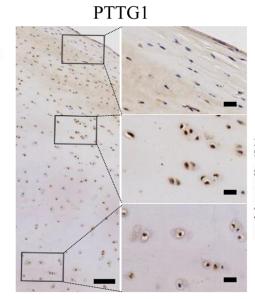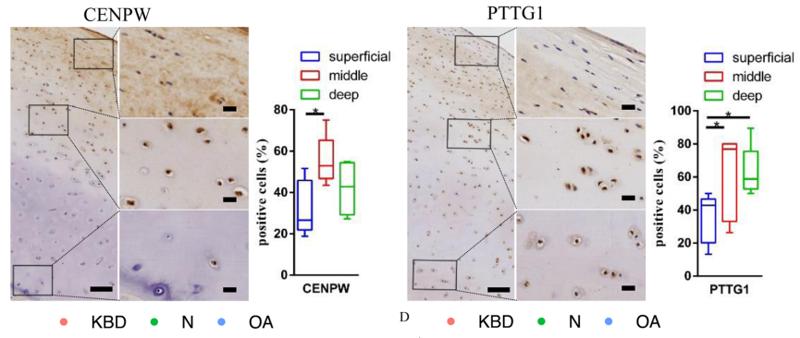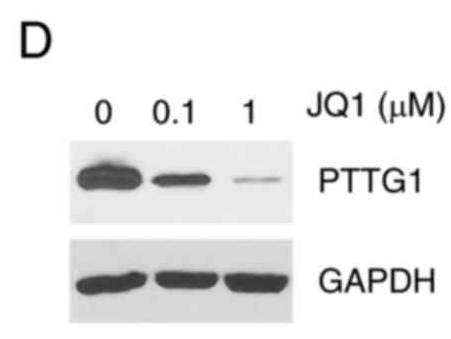产品描述
*The optimal dilutions should be determined by the end user.
*Tips:
WB: 适用于变性蛋白样本的免疫印迹检测. IHC: 适用于组织样本的石蜡(IHC-p)或冰冻(IHC-f)切片样本的免疫组化/荧光检测. IF/ICC: 适用于细胞样本的荧光检测. ELISA(peptide): 适用于抗原肽的ELISA检测.
引用格式: Affinity Biosciences Cat# AF0354, RRID:AB_2833520.
展开/折叠
AW555095; C87862; Cut2; EAP 1; EAP1; ESP1 associated protein 1; Esp1-associated protein; hPTTG; MGC126883; MGC138276; Pds1; Pituitary tumor transforming 1; Pituitary tumor transforming protein 1; Pituitary tumor-transforming 1, isoform CRA_a; Pituitary tumor-transforming 1, isoform CRA_b; Pituitary tumor-transforming gene 1; Pituitary tumor-transforming gene 1 protein; PTTG 1; PTTG; PTTG1; PTTG1 protein; PTTG1_HUMAN; Pttg3; Securin; Tumor transforming 1; Tumor transforming protein 1; Tumor-transforming protein 1; TUTR 1; TUTR1;
抗原和靶标
Expressed at low level in most tissues, except in adult testis, where it is highly expressed. Overexpressed in many patients suffering from pituitary adenomas, primary epithelial neoplasias, and esophageal cancer.
- O95997 PTTG1_HUMAN:
- Protein BLAST With
- NCBI/
- ExPASy/
- Uniprot
MATLIYVDKENGEPGTRVVAKDGLKLGSGPSIKALDGRSQVSTPRFGKTFDAPPALPKATRKALGTVNRATEKSVKTKGPLKQKQPSFSAKKMTEKTVKAKSSVPASDDAYPEIEKFFPFNPLDFESFDLPEEHQIAHLPLSGVPLMILDEERELEKLFQLGPPSPVKMPSPPWESNLLQSPSSILSTLDVELPPVCCDIDI
种属预测
score>80的预测可信度较高,可尝试用于WB检测。*预测模型主要基于免疫原序列比对,结果仅作参考,不作为质保凭据。
High(score>80) Medium(80>score>50) Low(score<50) No confidence
研究背景
Regulatory protein, which plays a central role in chromosome stability, in the p53/TP53 pathway, and DNA repair. Probably acts by blocking the action of key proteins. During the mitosis, it blocks Separase/ESPL1 function, preventing the proteolysis of the cohesin complex and the subsequent segregation of the chromosomes. At the onset of anaphase, it is ubiquitinated, conducting to its destruction and to the liberation of ESPL1. Its function is however not limited to a blocking activity, since it is required to activate ESPL1. Negatively regulates the transcriptional activity and related apoptosis activity of TP53. The negative regulation of TP53 may explain the strong transforming capability of the protein when it is overexpressed. May also play a role in DNA repair via its interaction with Ku, possibly by connecting DNA damage-response pathways with sister chromatid separation.
Phosphorylated at Ser-165 by CDK1 during mitosis.
Phosphorylated in vitro by ds-DNA kinase.
Ubiquitinated through 'Lys-11' linkage of ubiquitin moieties by the anaphase promoting complex (APC) at the onset of anaphase, conducting to its degradation. 'Lys-11'-linked ubiquitination is mediated by the E2 ligase UBE2C/UBCH10.
Cytoplasm. Nucleus.
Expressed at low level in most tissues, except in adult testis, where it is highly expressed. Overexpressed in many patients suffering from pituitary adenomas, primary epithelial neoplasias, and esophageal cancer.
Interacts with RPS10 and DNAJA1 (By similarity). Interacts with the caspase-like ESPL1, and prevents its protease activity probably by covering its active site. Interacts with TP53 and blocks its activity probably by blocking its binding to DNA. Interacts with the Ku 70 kDa subunit of ds-DNA kinase. Interacts with PTTG1IP.
The N-terminal destruction box (D-box) acts as a recognition signal for degradation via the ubiquitin-proteasome pathway.
The TEK-boxes are required for 'Lys-11'-linked ubiquitination and facilitate the transfer of the first ubiquitin and ubiquitin chain nucleation. TEK-boxes may direct a catalytically competent orientation of the UBE2C/UBCH10-ubiquitin thioester with the acceptor lysine residue.
Belongs to the securin family.
研究领域
· Cellular Processes > Cell growth and death > Cell cycle. (View pathway)
· Cellular Processes > Cell growth and death > Oocyte meiosis. (View pathway)
· Human Diseases > Infectious diseases: Viral > HTLV-I infection.
文献引用
Application: IHC Species: Human Sample: cartilage tissues
Application: IHC Species: human Sample: cartilage
Application: WB Species: Human Sample:
限制条款
产品的规格、报价、验证数据请以官网为准,官网链接:www.affbiotech.com | www.affbiotech.cn(简体中文)| www.affbiotech.jp(日本語)产品的数据信息为Affinity所有,未经授权不得收集Affinity官网数据或资料用于商业用途,对抄袭产品数据的行为我们将保留诉诸法律的权利。
产品相关数据会因产品批次、产品检测情况随时调整,如您已订购该产品,请以订购时随货说明书为准,否则请以官网内容为准,官网内容有改动时恕不另行通知。
Affinity保证所销售产品均经过严格质量检测。如您购买的商品在规定时间内出现问题需要售后时,请您在Affinity官方渠道提交售后申请。产品仅供科学研究使用。不用于诊断和治疗。
产品未经授权不得转售。
Affinity Biosciences将不会对在使用我们的产品时可能发生的专利侵权或其他侵权行为负责。Affinity Biosciences, Affinity Biosciences标志和所有其他商标所有权归Affinity Biosciences LTD.






